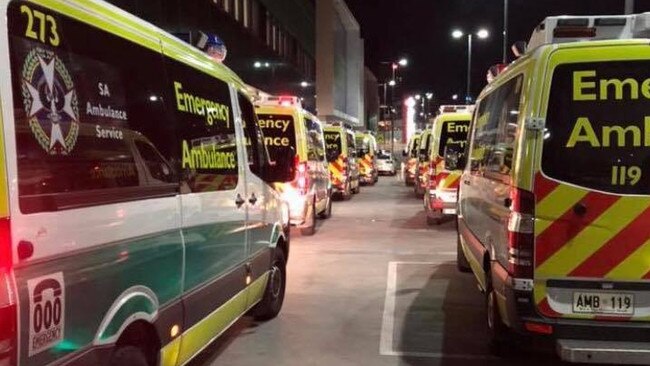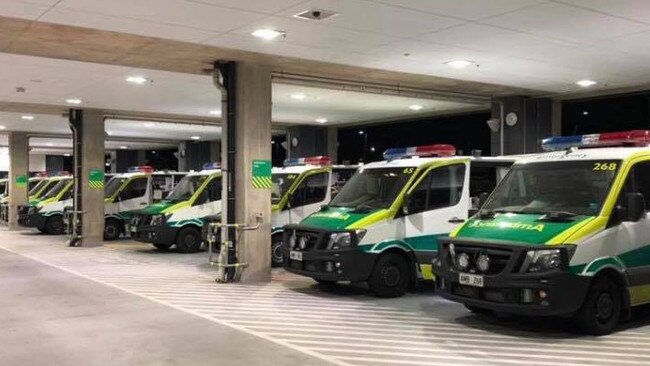SA health crisis: Record ramping as 18 ambulances stuck in $2.4 billion RAH’s carpark
PARAMEDICS have been given an all-clear to write anti-ramping slogans on ambulances and a doctor was attacked as ramping reached record levels at metro hospitals on Tuesday.
- Pregnant nurses banned from tending ambulances at $2.4bn RAH
- Surgery cases postponed as winter demand in EDs soared
- Ambulance ramping ‘the worst it’s been’
RECORD ambulance ramping that “put lives at risk” has triggered industrial action and a potential ban on transferring non-critical patients to overcrowded hospitals.
In a nightmare night where all metropolitan hospitals were on code white — operating beyond their EDs’ official capacity — on Monday and early on Tuesday:
THE $2.4 billion Royal Adelaide Hospital had a record 18 ambulances ramped in its carpark with patients waiting for a bed inside in the ED, leaving fewer available for emergency calls;
TEMPERS frayed as a doctor was assaulted by an agitated patient, requiring stitches to the lip;
CLINICIANS due to finish shifts at 11pm were still working at 1.30am, unwilling to leave colleagues overwhelmed by demand;
MORE than 100 patients were seeking help in the 71-cubicle RAH ED;
MENTAL health patients were stuck in the RAH ED for more than 40 hours after treatment waiting a placement bed, adding to delays for new arrivals.

The conga-line of ramped ambulances resembling a car yard continued throughout the night and the system remained under pressure during the day — at 9.30am on Tuesday the 800-bed RAH’s ED had 43 patients who had been seen but were waiting for a ward bed or placement.
These included including six patients waiting more than 24 hours and 11 waiting between 12 and 24 hours.
Exasperated unions are mobilising to seek solutions to the chronic gridlock, which came despite flu patient numbers tailing off.
Ambulance Employees’ Association SA president Phil Palmer said the past two days had seen “disastrous” ramping that “put lives at risk”.
The union has issued a notice to members authorising use of messages to be written on ambulance windows, so the public can see the extent of members’ concerns.
It is also calling for the State Government to waive all ambulance fees for any patient ramped because SA Ambulance cannot deliver a service that is “fit for purpose”, and is considering a statewide ban on transferring non-critical patients to any hospital already at capacity.
“The situation at the RAH is appalling and the ED overcrowding and ramping is impacting on the whole state,” Mr Palmer said.
“Country hospitals such as Murray Bridge are contributing to the problem by insisting on transferring patients to the RAH when it is already overcapacity. These patients end up being ramped for hours — it is counter-productive and contributes to ramping.
“On Sunday around 30 hours of ambulance crew availability were lost to the community, 16 of which were at the RAH. It got much worse on Monday where at least 64 hours were lost, 35 of which were at the RAH.”

Mr Palmer said members were “beyond furious” and are calling for union action.
“We are considering a statewide ban on transferring any non-critical patient from any hospital to one that is ramping/overcrowded,” he said.
SA Salaried Medical Officers Association industrial officer Bernadette Mulholland went to the RAH at 11.30pm on Monday to consult members and was shocked at the sight.
“At that stage there were 14 ambulances ramped and 106 patients in an ED with 71 cubicles — it was incredibly overwhelming,” she said.
“Some mental health patients had been waiting there for more than 40 hours, which reinforces our view there is an urgent need for more mental health resources in SA.
“One doctor was assaulted and needed a couple of stitches in the lip — it is not a great environment to work in.”
Ms Mulholland said senior staff who were due to finish work at 11pm were still there at 1.30am, unwilling to leave overworked colleagues to deal with the demand.
“It was quite frantic — people were looking really, really tired,” she said. “One doctor said it was almost like being in the third world, looking out and seeing all the ambulances ramped.”
One doctor said it was almost like being in the third world, looking out and seeing all the ambulances ramped.
SASMOA officials are meeting with Health and Wellbeing Minister Stephen Wade and the chief psychiatrist next week to discuss the need for more resources for mental health patients.
“The frustration is palpable among the clinical workforce — they want to find solutions,” Ms Mulholland said.
Premier Steven Marshall described ramping as a “difficult situation” and said there was “no silver bullet” to fix it.
“The overcrowding and the ramping is completely unacceptable,” he said.
“The reality is this was always going to happen; Transforming Health was closing down hundreds of beds across South Australia.
“That was always going to put pressure on our major hospitals and we’re working as quickly as we can to alleviate those problems.”

